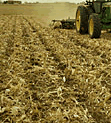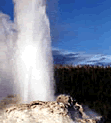- Global Warming;
Global Warming;
- Disappears of some animals, plants and humans life;
- Environment damage because of chemical and toxic waist;
All this destruction at above are related to each other in one way or an other. But it is necessary to define each one of this problems; what are they, effects to our ecosystem and what's cause them, separately which then it will able us to search, find and list solutions.
- Global Warming: The world's climate has not been constant. We know it has gone through dramatic past changes, but there is increasing evidence that human activities are altering our climate at an unprecedented rate. This is the one of the most significant problem that the world has ever faced. This is what called claimant change, the world temperature is getting higher every year and each living thins are aware of this, at when summers are longer and hotter. The effects of this problem, seen such as when high rain falls, snow melts fast which causes floods in many part of the world and this distracts earth ecological system and human life.
Global warming is caused by different kind gases such as water vapor, carbon dioxide, methane, nitrous oxide, ozone, and chlorofluorocarbons etc. These gases are produce by factory smokes, our most transports smoke, some sprays, basically most of them from burning different kind of fiule and these gives greenhouse effect to our atmosphere. Inside an artificial greenhouse filled with plants, the surrounding glass traps the sun's energy, making it warm inside, even while outside the temperature may be much colder.
Must be mention; losing a tree in the forests, either way because of fire or cut by humans, to use them as a wood, paper or to make open area to use in different proposes also helps to increases to greenhouse effect. The forests are which everybody knows that produce an oxygen and also cleans air from these kind of gases we said at above, for the world life.
-Disappears of some animals, plants and human life: The smallest temperature rising affects to the world life that is including earth, water, air, animals, plants, microorganism and human life. Some of the living things can adapt to this change but most can not live. Toxic waists are also an other factor that humans cause to natural world including our self. Every living creature is very important in this universe and dissappearns of one kind affects to the other kinds livings and this is called balance of life.
-Environment Damage because of chemical and toxic waist: The chemical waists are made usually again by humans. It usually is the product of industry or commerce, but comes also from residential use, agriculture, the military, medical facilities, radioactive sources, and light industry, such as dry cleaning establishments. The damage gained from these leftovers are very hard to repair, they have long-term risk to health or to the world ecological system.
Toxic can be released into air, water, or land. Toxic are hazardous industrial chemicals, including halogenated fluorocarbons, dioxin, asbestos , polychlorinated biphenyls (PCBs), and vinyl chloride. Toxic waste treatment and control has proved to be expensive and time-consuming with more resources spent on court battles than on actual cleanup. In some cases such wastes are shipped to developing countries for cheap disposal without the informed consent of their governments. The often substandard shipping, storage, and treatment methods endanger human health and the health of the environment.
What can we do?
As individuals can do something to reduce the threat of climate change. Many actions are simple and can even save money:
-Switching off electrical appliances instead of leaving them on standby, and turning down the central heating by a mere 1°C, are useful first steps. Insulating the house and buying energy-efficient electrical equipment and light bulbs will also make a big difference: some compact fluorescent bulbs can last 10,000 hours and use only 20 per cent of the electricity consumed by ordinary bulbs. You can also choose an electricity company that offers a green tariff by supplying electricity from renewable energy sources.
-Cutting out just one car journey a week is another good idea. Try walking or cycling instead - it will also help you keep fit. Buying a fuel-efficient car - and, better still, using public transport wherever possible - can also cut emissions dramatically.
-Other simple actions that will benefit the climate include buying local produce instead of goods that have been flown in from around the world, reusing and recycling energy-intensive materials such as paper, glass and aluminum, and not buying anything with a lot of unnecessary packaging, especially plastic.
What The World Nations Can Do?
The world nations should make an investment in research and development of clean energy which is called renewable energy technologies. There are types of renewable energy technologies that in use by some countries today and some of these are needs to more research to develop further.
What Is Renewable Energy Technologies?
Renewable energy technologies (RETs) are clean sources of energy that have a much lower environmental impact then conventional energy technologies. RETs are alternatives to fossil fuels such as coal, oil and natural gas, which pollute the atmosphere, and to nuclear power, which creates radioactive waste that's difficult to dispose of.
At this moment, many countries dependence on foreign oil supplies. Most RETs investments are spent on materials and workmanship to build and maintain the facilities, rather than on costly energy imports. RETs investments are usually spent within the same country, and often in the same town. This means your energy money stay home to create jobs and fuel local economies, rather than going overseas. Renewable energy will not run out ever but other sources of energy are finite and will some day be depleted.
The more RETs build a round the world, the larger scale of production, the cheaper renewable will become at the same time aids protection of our ecosystem. The known renewable energies are:
| -Solar energy; |
-Wind energy; |
-Biomass energy; |
| -Hydrogen energy; |
-Geothermal energy; |
-Ocean energy; |
-Solar energy: Solar water heating is one of the most common uses of solar energy. Solar hot  water collectors heat water for washing, showers, and other domestic uses. Solar cells absorb sunlight and convert it directly to electricity. Most are rectangular or circular wafers made of silicon (sand), but some consist of a thin film that is mounted on glass or thin metal. When sunlight hits the cell, electrons are released. The electrons then flow onto wires, forming direct current (DC), which is the same kind of current that flows from a regular battery (it can be able to design and then power up house hold electrical items). A four-inch silicon cell can produce about one watt of DC electricity and have a working life of 20 - 30 years.
water collectors heat water for washing, showers, and other domestic uses. Solar cells absorb sunlight and convert it directly to electricity. Most are rectangular or circular wafers made of silicon (sand), but some consist of a thin film that is mounted on glass or thin metal. When sunlight hits the cell, electrons are released. The electrons then flow onto wires, forming direct current (DC), which is the same kind of current that flows from a regular battery (it can be able to design and then power up house hold electrical items). A four-inch silicon cell can produce about one watt of DC electricity and have a working life of 20 - 30 years.
 -Wind energy: We have been harnessing the wind's energy for hundreds of years. From old Holland to farms, windmills have been used for pumping water or grinding grain.
-Wind energy: We have been harnessing the wind's energy for hundreds of years. From old Holland to farms, windmills have been used for pumping water or grinding grain.
Today, the windmill's modern equivalent is a wind turbine, can use the wind's energy to generate electricity. A single modern wind turbine can produce enough power to meet the annual electricity needs of 500 average homes.
A wind turbine works in following way: Standing as tall as 300 feet to capture the full force of the wind, modern wind turbines use state-of-the-art technology to turn wind into electricity. When the wind blows, the blades begin to spin, t u rning an electric generator to create electricity. This electricity is carried through the turbine tower underground, where it feeds into the electric grid.
-Biomass energy: Biopower is the process of using biomass (plant and organic matter) to generate electricity.  Biomass has been used for lighting, cooking, and heating ever since humans first discovered fire. Today, modern biomass generating plants can produce hundreds of megawatt-hours of electricity in a manner similar to generating electricity using fossil fuels. In essence, the fossil fuels are simply replaced with plant matter as a fuel source, creating a cleaner, renewable energy alternative.
Biomass has been used for lighting, cooking, and heating ever since humans first discovered fire. Today, modern biomass generating plants can produce hundreds of megawatt-hours of electricity in a manner similar to generating electricity using fossil fuels. In essence, the fossil fuels are simply replaced with plant matter as a fuel source, creating a cleaner, renewable energy alternative.
Plants absorb and store energy from the sun as they grow. With the right technologies and careful attention to responsible land-management practices, the energy contained in plants can be harnessed to produce heat and electricity. Sustainable, dedicated energy crops have the potential to supply a significant portion of energy needs while providing farmers with a valuable new market for their crops.
The use of biomass energy has the potential to greatly reduce our greenhouse gas emissions. Biomass generates about the same amount of carbon dioxide as fossil fuels, but every time a new plant grows, carbon dioxide is actually removed from the atmosphere.
-Hydrogen energy: Hydrogen is high in energy, yet an engine that burns pure hydrogen produces almost no pollution. Hydrogen can be generated from clean, renewable energy by running an electric current through water, called 'electrolysis', which separates the water into hydrogen and oxygen gas. The hydrogen is then stored as the fuel for fuel cells.
NASA has used liquid hydrogen since the 1970s to propel the space shuttle and other rockets into orbit. Hydrogen fuel cells power the shuttle's electrical systems, producing a clean byproduct of pure water, which the crew drinks.
Fuel cells are being used to power homes and businesses now and automobile manufacturers already have fuel cell vehicles on the road for testing. Honda and Toyota delivered fuel cell vehicles to California in 2002, and plan to put another 60 vehicles on the road in 2003.
 -Geothermal energy: Geothermal energy is right under our feet. The Earth's core is like an inner sun, heating the Earth's surface and warming the water and rocks beneath. This steaming water and rock can be used to generate heat and electricity. The uppermost six miles of the Earth's crust alone contains more energy than all the oil and gas reserves in the world. Geothermal resources are abundant, affordable, and available 24 hours a day, 365 days a year. Currently, geothermal energy provides enough electricity to power nearly 4 million American homes.
-Geothermal energy: Geothermal energy is right under our feet. The Earth's core is like an inner sun, heating the Earth's surface and warming the water and rocks beneath. This steaming water and rock can be used to generate heat and electricity. The uppermost six miles of the Earth's crust alone contains more energy than all the oil and gas reserves in the world. Geothermal resources are abundant, affordable, and available 24 hours a day, 365 days a year. Currently, geothermal energy provides enough electricity to power nearly 4 million American homes.
-Ocean energy: The ocean can produce two types of energy; thermal energy from the sun's heat, and mechanical energy from the tides and waves. Oceans cover more than 70% of Earth's surface, making them the world's largest solar collectors. The sun's heat warms the surface water a lot more than the deep ocean water, and this temperature difference creates thermal energy. Just a small portion of the heat trapped in the ocean could power the world.
The ocean can produce two types of energy; thermal energy from the sun's heat, and mechanical energy from the tides and waves. Oceans cover more than 70% of Earth's surface, making them the world's largest solar collectors. The sun's heat warms the surface water a lot more than the deep ocean water, and this temperature difference creates thermal energy. Just a small portion of the heat trapped in the ocean could power the world.
Conclusion:
The reality is, there is no other planet in this universe that suitable for living thing to bereave and feat from as in this world. It is possible to protect our world from distractions as we know now as individual humans and countries.
There are ways to protect our environment and the starting point should be; first our homes then our streets, towns, counties, country's and then world as a hole. There are many RETs but down site of these technloges that thay need huge land to be developed in, can effect on seenary of land, still they can produse small amount of polution. Benefits are huge, to countries will get cleaner air, more employed people and economy boost, to land owners who are farming for their lifes will get extra good income and they do not need to refruce to cities for work any more.
It is possible to get more detiled information out about ecosystem protection and RETs, from easy as click on search to Internet. Please help our ecosystem, our self and our future generations.
Acknowledgment
To gather all these information, mostly I used an Internet . I would like to thanks all the individual companies or organizations that I list under reference; they produced and published information about enviromental issues, at their web sites for entire world to read and know.
I believe that these companies or organizations have no objection to me, to use some of there publised information in a good way at in this research.
Thank you all....
Reference